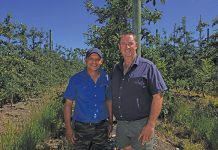With the European market saturated, South Africa needs to explore other export markets. Charles Hughes, chief executive officer of Tru-Cape Fruit Marketing, believes the Far East, and China in particular, present local producers with opportunities. He shared these insights at the recent Agri Outlook conference. Cornelia du Plooy reports.
China, a country of 1,3 billion people, has the potential to be either a land of massive opportunity, or a world threat at the centre of fears for food and product safety and quality. While Japan was rising as an economic power, China remained cloaked in communism. Then 20 years ago the dragon awoke, and China embarked on the Beijing Plan to rebuild its economy. The crux of the plan was the realisation that the country’s economic edge was its population, and China soon became a world economic player. T he West rapidly sought joint ventures such as VW, Toyota, GM, and Nike. In the process, both China and the West have called for massive economies of scale as global companies chased profits while ignoring quality. Why court China? SA has much to gain from clear strategies regarding China. Our countries are counter-seasonal, which means we aren’t competitors. We have a wealth of experience to share and they have a variety of products we can use – a perfect win-win situation. R ecent research by Prof Daan Louw of the University of the Free State concludes there are few differences between China and SA regarding the costs of money (if borrowing is required), land (which is actually more expensive in China), trees, fertiliser, pesticides, fungicides, labour (which is increasing rapidly), packaging and cold storage, and shipment to major markets. he main differences lie in the number of farmers and the size of farms.
An average SA farm is 45ha, while in China it’s only 0,2ha to 0,3ha. Our 700-plus apple farmers cover 32 000ha. China’s 70 million farmers cover 1,9 million hectares. China can offer us their valuable experience of small-scale farming and land reform. countries have similar growing conditions and percentages of available land, with 50% of both populations relying on agriculture. We also have similar problems with climate and water.
A t present the only Chinese fresh product SA imports is garlic, and only in our off-season. We also import fruit juice concentrate. Recently SA agreed to export citrus and grapes to China, while they export apples and pears to us. By agreement, SA company Tru-Cape Fruit Marketing have sourced Chinese plant material for apples and pears on an exclusive basis, offering SA plant material in return. This gives Tru-Cape a chance to export to China and gain technical knowledge. The dragon awakens China has developed dramatically since 1949. Land reforms gave peasants land and, during the “golden time” between 1953 and 1957, yearly production rose 4,5%. From 1958 to 1978 agriculture slowed to only 2,5%, as government cooperative commune schemes and centralised management, ruled out free enterprise. But in 1978, this was replaced with a “household contract responsibility” system, which allowed controlled free enterprise, renewing growth. From 1985 the government eliminated state monopolies on purchasing, marketing and contracts, leading to increased production, competitive marketing and unprecedented growth in produce and support industries. Staple crops, animal husbandry and fisheries exploded while cash crops and grains dropped. Over the next 21 years China’s agricultural gross output value hit 6,5%. At 12,4% in 1984, it beat world averages. By 1999 production increased all round, encompassing grain, cotton, oil crops, meat and aquaculture, and shortages disappeared.
What SA has to gain Now China’s economic growth, leading to greater disposable income, is creating new shortages. A major importer once again, China is exploring the world for supplies and production opportunities. The need is dire, as China feeds 21% of the world’s population on 9% of the world’s total cultivated land. SA only produces 1% of the world’s apples and 2% of its pears. China is the largest producer of apples, at 40% of world production (5,6 times more than the US), and the largest producer of pears at 61% of world production (14 times more than Italy). Yet China only exports 8% of what it produces, and imports far more. Its economy is growing at over 12% a year and it pays substantial premiums for quality produce. But to appreciate the opportunity it presents, one has to understand China’s needs. Despite its high production, China needs to import Fuji and Royal Gala apples, both priority plantings in SA. Biofuel crops could also be a major priority. With economic growth of 12,5%, China’s vehicle sales have exploded. Beijing alone sees 100 000 new vehicles monthly. The result is an enormous demand for oil, hence the current prices. Biofuel is the next growth area presenting a huge opportunity for SA. Imports and safety he recent pineapple fertiliser disaster and the pet food and baby food crises have placed China in a bad light. This could have been avoided if proper quality assurance procedures had been in place.
Tru-Cape’s own experiences have shown that working with both governments (and China) with clear rules of engagement, guarantees product safety. Some fertilisers and chemicals are under review, but they are good quality and competitively priced. A ll imports are subject to strict phytosanitary protocols, prescribing strict quality requirements, strict timing of delivery and value chain protection as well as full farm, orchard and packhouse accreditation. Neither country wishes to suffer “dumping”. China’s window of opportunity is very short, only 10 to 12 weeks in between our own seasons, and the values are measured in dollars. The market is small and shipping is expensive. As shipping time is 35 days, it’s unlikely that many imports will come into SA. China sets sights on Africa China has already identified Africa for development, and targeted both and the continent as a whole to receive a wide range of products. The continent has the potential to grow many staples, and China is willing and able to invest millions of dollars to achieve this. Beijing in particular has 12 projects covering a host of sustainable crops. In they plan to develop aquaculture in the northern provinces. should pursue bilateral agreements to attract funds from China to develop unused or underused land for export. would do well to follow China’s small-scale farming principles, helping new farmers develop unused land and growing suitable crops by region. And of course, we should learn from their past mistakes and tap into their current successes. Visit www.tru-cape.com. |fw
China’s key objectives
China has seven key objectives, all of which offer positive outcomes for cooperation:
1. Increasing farmers’ income by promoting cost-effective agriculture, using scientific and technological advances; increasing economic returns from farming operations; and promoting the industrialisation of agriculture and development of secondary and tertiary industries with township enterprises as a major player.
2. Increasing grain production capacity, by strictly protecting farm land and ensuring its capital construction.
3. Continuing to promote agricultural restructuring, through regionalised, competitive programmes that will speed up the development of industrial belts producing agroproducts.
4. Actively promoting progress in agroscience, enhancing research programmes and increasing reserve levels.
5. Opening agriculture to the outside world by developing agricultural trade with other countries, and making use of foreign funds.
6. Improving rural labour conditions, and developing rural industries and small towns.
7. Continuing to deepen rural reforms.
Rural land reforms are a particular priority as far as administrative charges and tax, grain distribution systems and rural financial systems are concerned.
China’s huge growth means their production can’t meet their needs, so they’re looking for trading partners.
China has expertise to share on small-scale farming and land reform.
But – Chinese imports may harm our domestic production.








